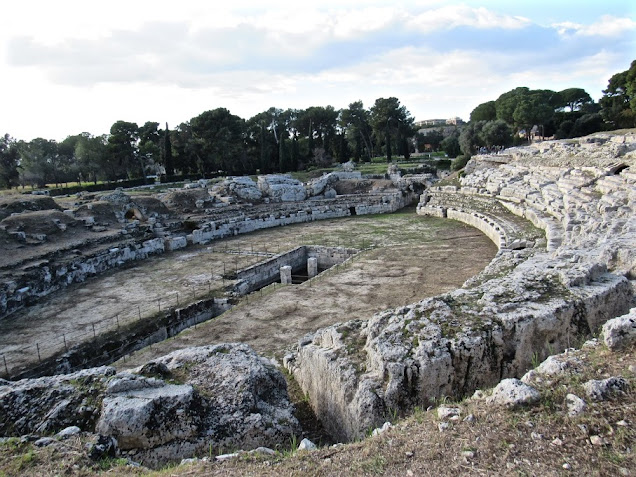Sicily: Syracuse
After more than a week of delicious food and beautiful cities, I thought I'd seen it all in Sicily. Oh how wrong I was! On one of our longer day trips from Bronte, a small village near Mt. Etna, we explored a city with ancient ruins, impressive architecture, and lovely beaches.
Our day started out with snow! I didn't think it was possible with Sicily being so far south. However, Bronte is in the mountains and it was actually pretty chilly there in February.
We left the meager amount of snow behind when we drove down to the coastal city of Syracuse.
Syracuse (Siracusa in Italian) was one of the major powers of the ancient world. It was a Greek city-state, and is a tourist destination today because of the impressive Greek architecture that remains.
Even before we visited the ancient ruins, I immediately fell in love with these beautiful pastel streets. 10 minutes after leaving the car, I was already daydreaming about being rich enough to buy a vacation home here.
The city's main cathedral was a surprise. It looks baroque on the the outside, but parts of the interior date from the 5th century B.C.
The columns of the original Greek temple were incorporated into the current cathedral (built in the 7th century A.D.).
After some lunch (can you say homemade pasta?), we took the long way back to the car to stroll along the coast.
A short drive later, we arrived at the Archeological Park of Syracuse. Our first stop there was the Ear of Dionysus- a limestone cave carved into the side of the mountain. The cave was used for water storage and later as a prison for political opponents of the city's tyrant ruler Dionysus. Legend has it that Dionysus enjoyed that the perfect acoustics of the cave amplified the screams of prisoners being tortured inside.
On that note.
Syracuse's Greek Theater (5th century B.C.) is very well preserved and could seat 15,000 spectators. It was one of the largest and most impressive in the Greek world. The theater used to border the sea (like in Taormina), but the coast has since moved a few miles away.
The Roman Amphitheater (3rd century A.D.) is just a few minute's walk away. It is not quite as well preserved despite being a few centuries newer. While the Greeks used their theater for more civilized entertainment like plays, the Romans preferred to use theirs for bloody gladiator fights. Some archeologists think that one of the uses for the sunken room in the middle (with attached canals) was to collect blood from the arena.
Our day started out with snow! I didn't think it was possible with Sicily being so far south. However, Bronte is in the mountains and it was actually pretty chilly there in February.
We left the meager amount of snow behind when we drove down to the coastal city of Syracuse.
Syracuse (Siracusa in Italian) was one of the major powers of the ancient world. It was a Greek city-state, and is a tourist destination today because of the impressive Greek architecture that remains.
Even before we visited the ancient ruins, I immediately fell in love with these beautiful pastel streets. 10 minutes after leaving the car, I was already daydreaming about being rich enough to buy a vacation home here.
The columns of the original Greek temple were incorporated into the current cathedral (built in the 7th century A.D.).
After some lunch (can you say homemade pasta?), we took the long way back to the car to stroll along the coast.
A short drive later, we arrived at the Archeological Park of Syracuse. Our first stop there was the Ear of Dionysus- a limestone cave carved into the side of the mountain. The cave was used for water storage and later as a prison for political opponents of the city's tyrant ruler Dionysus. Legend has it that Dionysus enjoyed that the perfect acoustics of the cave amplified the screams of prisoners being tortured inside.
On that note.
Syracuse's Greek Theater (5th century B.C.) is very well preserved and could seat 15,000 spectators. It was one of the largest and most impressive in the Greek world. The theater used to border the sea (like in Taormina), but the coast has since moved a few miles away.
The Roman Amphitheater (3rd century A.D.) is just a few minute's walk away. It is not quite as well preserved despite being a few centuries newer. While the Greeks used their theater for more civilized entertainment like plays, the Romans preferred to use theirs for bloody gladiator fights. Some archeologists think that one of the uses for the sunken room in the middle (with attached canals) was to collect blood from the arena.


























Comments
Post a Comment